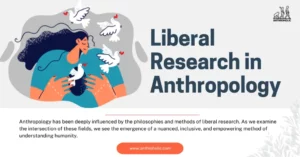AI Answer Evaluation Platform Live Now. Try Free Answer Evaluation Now
Digital Anthropology
As technology continues to shape and reshape our world, it is crucial to understand its impact on human society and culture. This pressing need has given rise to a new field of study: digital anthropology. Digital anthropology is the study of human interaction and culture in the digital realm, encompassing a wide range of online and offline activities.

Brief History of Digital Anthropology
The foundations of digital anthropology can be traced back to the mid-20th century when scholars began to examine the social implications of new technologies [8]. As computers and the internet became more prevalent in everyday life, anthropologists realized the potential for studying human behavior in these digital spaces. In the 1990s, as the World Wide Web became more accessible, the field of digital anthropology began to take shape. Scholars like Arturo Escobar (1994) and George Marcus (1995) were among the first to recognize the need for an anthropological approach to the digital world. Their groundbreaking work laid the foundation for digital anthropology as a distinct field.
Key Concepts in Digital Anthropology
- Digital Divide: The digital divide refers to the gap between individuals, households, businesses, and geographic regions concerning their access to information and communication technologies (ICTs). Digital anthropologists examine the social, economic, and political factors that contribute to this divide, as well as its implications for global inequality [4].
- Digital Identity: Digital identity is the way individuals present themselves and interact with others in digital spaces. Digital anthropologists study the construction of digital identities, examining aspects such as social media profiles, avatars, and online personas [6].
- Cyberculture: Cyberculture encompasses the cultural practices, norms, and values that have emerged in digital spaces. Digital anthropologists explore how these online cultures are formed, sustained, and changed over time [1].
- Online Communities: Online communities are groups of individuals who interact through digital platforms, such as social media, forums, and chat rooms. Digital anthropologists study the social dynamics, rituals, and behaviors within these communities [10].
Methodology in Digital Anthropology
- Ethnography: Digital ethnography is a primary method used in digital anthropology. It involves the immersive and participatory study of online communities and digital spaces. Researchers engage with participants through online platforms, conduct interviews, and observe digital interactions to understand the dynamics of digital culture [5].
- Big Data Analysis: The use of big data in digital anthropology allows researchers to analyze large datasets to identify patterns, trends, and relationships within digital cultures. This method often involves the use of computational tools and algorithms to process and analyze data [2].
- Mixed Methods: Many digital anthropologists employ mixed methods, combining qualitative and quantitative approaches to explore digital phenomena. This can involve using ethnographic data to inform big data analysis or integrating data from multiple sources to provide a more comprehensive understanding of digital culture [9].
The Significance of Digital Anthropology in Contemporary Society
- Understanding the Digital Realm: As the digital world becomes increasingly intertwined with our everyday lives, digital anthropology helps us understand the social and cultural implications of this shift. By examining the ways in which people interact, communicate, and form communities in digital spaces, digital anthropologists provide valuable insights into the contemporary human experience [8].
- Bridging the Digital Divide: By studying the factors that contribute to the digital divide, digital anthropologists can provide valuable insights into strategies for addressing and reducing digital inequalities. This knowledge can help inform the development of policies and initiatives aimed at fostering digital inclusion and access for all [4].
- Navigating Digital Identity: As digital identities become more prevalent, understanding their construction and implications is crucial. Digital anthropologists can offer guidance on how to navigate the complexities of digital identity, both in terms of personal online presence and the ways in which digital identities impact social relationships and interactions [6].
- Informing Technological Development: By examining the social and cultural implications of digital technologies, digital anthropologists can help inform the design and development of new technologies that are more sensitive to the needs and concerns of users. This can lead to more inclusive and equitable digital tools and platforms [9].
Conclusion
Digital anthropology is a vital field of study that enables us to understand the complex and rapidly evolving landscape of human interaction and culture in the digital age. From the digital divide to online communities, digital anthropologists provide essential insights into the ways in which digital technologies shape our lives and inform our understanding of the world. As we continue to navigate the digital era, the contributions of digital anthropology will become increasingly important for guiding our understanding of the social and cultural implications of the digital realm.
See Also
References
[1] Bell, D. (2001). An introduction to cybercultures. Routledge.
[2] Boyd, D., & Crawford, K. (2012). Critical questions for big data: Provocations for a cultural, technological, and scholarly phenomenon. Information, Communication & Society, 15(5), 662-679.
[3] Escobar, A. (1994). Welcome to Cyberia: Notes on the anthropology of cyberculture. Current Anthropology, 35(3), 211-231.
[4] Graham, M., & Dutton, W. H. (2019). Society and the Internet: How networks of information and communication are changing our lives. Oxford University Press.
[5] Hine, C. (2015). Ethnography for the Internet: Embedded, embodied, and everyday. Bloomsbury Publishing.
[6] Hogan, B. (2010). The presentation of self in the age of social media: Distinguishing performances and exhibitions online. Bulletin of Science, Technology & Society, 30(6), 377-386.
[7] Marcus, G. E. (1995). Technoscientific imaginaries: Conversations, profiles, and memoirs. University of Chicago Press.
[8] Miller, D., & Horst, H. A. (2012). Digital anthropology. Berg.
[9] Miller, D., Costa, E., Haynes, N., McDonald, T., Nicolescu, R., Sinanan, J., … & Wang, X. (2016). How the World Changed Social Media. UCL Press.
[10] Postill, J., & Pink, S. (2012). Social media ethnography: The digital researcher in a messy web. Media International Australia, 145(1), 123-134.



